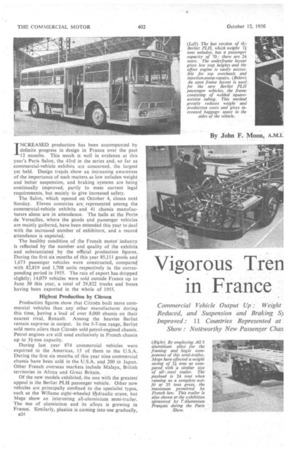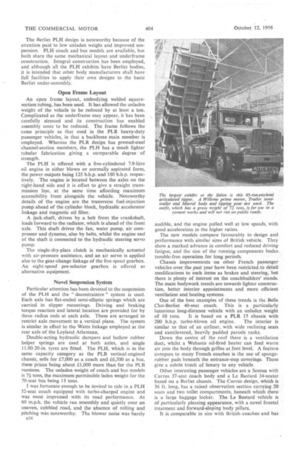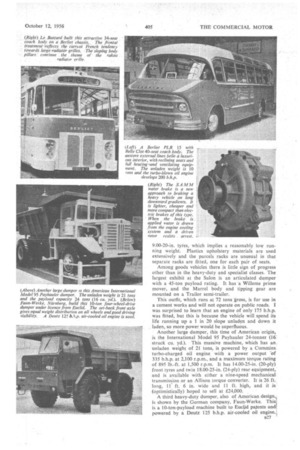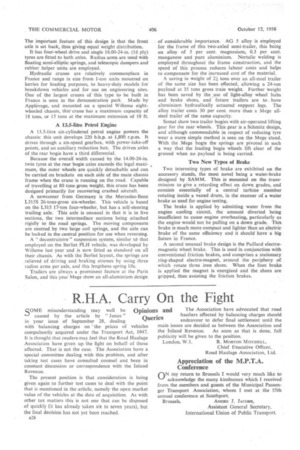Vigorous Tren in France
Page 58

Page 59

Page 60

Page 61

Page 62

If you've noticed an error in this article please click here to report it so we can fix it.
Commercial Vehicle Output Up: Weight Reduced, and Suspension and Braking Si improved: 11 Countries Represented at Show : Noteworthy New Passenger Chas INCREASED production has been accompanied by definite progress in design in France over the past 12 months. This much is well in evidence at this year's Paris Salon, the 43rd in the series and, so far as commercial-vehicle exhibits are concerned, the largest yet held. Design trends show an increasing awareness of the importance of such matters as low unladen weight and better suspension, and braking systems are being continually improved, partly to meet current legal requirements, but mainly to give increased safety.
The Salon, which opened on October 4, closes next Sunday. Eleven countries are represented among the commercial-vehicle exhibits and 41 chassis manufacturers alone are in attendance. The halls at the Porte de Versailles, 'where the goods and passenger vehicles are mainly gathered, have been extended this year to deal with the increased number of exhibitors, and a record attendance is expected: .
The healthy condition of the French motorindustry is reflected by the number and quality of the exhibits and substantiated . by the official production figures.. During the first six months of this year 85,111 goods and 1,673 passenger vehicles were constructed, compared with 82,819 and 1,708 units respectively in the corresponding period in 1955. The rate of export has dropped slightly; 14,079 vehicles were sold outside France up to June 30 this year, a total of 29,822 trucks and buses having been exported in the whole of 1955.
Highest Production by Citroen Production figures show that Citroen built more commercial vehicles than any other manufacturer during this time, having a lead of over 8,000 chassis on their nearest rival, Renault. Among the heavies Berliet remain supreme in output. In the 5-7-ton range, Bernet sold more oilers than Citroen sold petrol-engined chassis. Petrol engines are still used exclusively in French chassis up to 31-ton capacity.
During last . year 874 commercial vehicles were exported to the Americas, 15 of them to the U.S.A. During the first six months of this year nine commercial chassis have been sold in the U.S.A. and 200 in Japan. Other French overseas markets. include Malaya, British territories in Africa and Great Britain.
Of the new models exhibited, the one with the greatest appeal is the Berliet PLH passenger vehicle. Other new vehicles are principally confined to the specialist types, such as the Willeme eight-wheeled INdraulic crane, but Mege show an interesting all-aluminium semi-trailer. The use of aluminium and its alloys is growing in France. Similarly, plastics is coming into use gradually, B24 although its application is so far restricted to trimming materials in coaches and insulation for food vans.
The British exhibits are mainly among the cars, at the Grand Palais. Austins show an Omnicoach, a Land Rover is exhibited, and a Karrier Bantam oiler and a Commer Cob are displayed on the attractively . laid-out Rootes ,stand. The news has now leaked out about the Rootes 2.26-litre oil engine being made by the Standard Motor Co., Ltd., this secret having been kept throughout the Commercial Motor Show in London.
Rootes representatives told me that they had had many inquiries regarding the Bantam and the new engine, such a combination being unobtainable in France. At the Porte de Versailles, where the main commercial-vehicle exhibits are displayed, Britain is represented by a Bedford 7-ton oiler and a complete range of Perkins oil engines. Ten German and six American chassis makers are exhibiting this.year.
The Bernet PLH design is noteworthy because of the attention paid to low unladen weight and improved suspension. PLH coach and bus models are available, but both share the same mechanical layout and underframe construction. Integral construction has been employed, and although all the PLH exhibits have Berliet bodies, it is intended that other body manufacturers shall have full facilities to apply their own designs to the basic Berliet under-assembly.
Open Frame Layout An open frame layout, embodying welded squaresection tubing, has been used. it has allowed the unladen weight of the vehicle to be reduced by at least a ton. Complicated as the underframe may appear, it has been carefully stressed arid its construction has enabled assembly costs to be reduced. The frame follows the same principle as that used in the PLR heavy-duty passenger vehicles, in that a backbone main member is employed. Whereas the PLR design has pressed-steel channel-section members, the PLH has a much lighter tubular fabrication giving a comparable degree of strength.
The PLH is offered with a five-cylindered 7.9-litre oil engine in either blown or normally aspirated form, the power outputs being 125 b.h.p. and 160 b.h.p. respectively. The engine is located between the axles on the right-hand side and it is offset to give a straight transmission line, at the same time affording maximum accessibility from alongside the vehicle. Noteworthy details of the engine are the transverse fuel-injection pump ahead of the cylinder block, hydraulic accelerator linkage and magnetic oil filter_ A jack-shaft, driven by a belt from the crankshaft, leads forward to the radiator, which is ahead of the front axle. This shaft drives the fan, water pump, air compressor and dynamo, also by belts, whilst the engine end of the shaft is connected to the hydraulic steering servo pump.
The single-dry-plate clutch is mechanically actuated with air-pressure assistance, and an air servo is applied also to the gear-change linkage of the five-speed gearbox. An eight-speed pre-selector gearbox is offered as alternative equipment.
Novel Suspension System Particular attention has been devoted to the suspension of the ?LH and the " decontraintre " system is used. Each axle has flat-ended semi-elliptic springs which are carried in slipper mountings. Driving and braking torque reaction and lateral location are provided for by three radius rods at each axle. These are arranged to restrict axle movement to a vertical plane. The system is similar in effect to the Watts linkage employed at the rear axle of the Leyland Atlantean.
Double-acting hydraulic dampers and hollow rubber helper springs are used at both axles, and single 11.00-20-in. tyres are fitted. The PLH, which is in the same capacity category as the PLB vertical-engined chassis, sells for £7,000 as a coach and £6,500 as a bus, these prices being about 11,000 more than for the PLB versions. The unladen weight of coach and bus models is 74 tons, the maximum permissible laden weight for the 70-seat bus being 13 tons.
I was fortunate enough to be invited to ride in a PLH 32-seat coach equipped with turbo-charged engine and was most impressed with its road performance. At 60 m.p.h. the vehicle ran smoothly and quietly over an uneven, cobbled road, and the absence of rolling and pitching was noteworthy. The blower noise was barely R26 audible, and the engine pulled well at low speeds, with good acceleration in the higher ratios.
The new models compare favourably in design and performance with similar sizes of British vehicle. They Show a marked advance in comfort and reduced driving fatigue, and the size of the running components bodes trouble-free operation for long periods.
Chassis improvements on other French passenger vehicles over the past year have been restricted,to detail modifications to such items as brakes and steering, but there is plenty of interest on the coachbuildere stands. The main bodywork trends are towards lighter construction, better interior appointments and more efficient ventilation and heating systems.
One of the best examples of these trends is the Belle Clot-Berliet 40-seat coach. This is a particularly luxurious long-distance vehicle with an unladen weight of 10 tons. It is based on a PLR 15 chassis with 200 b.h.p. turbo-blown oil engine. The interior is similar to that of an airliner, with wide reclining seats and cantilevered, heavily padded parcels racks.
Down the centre of the roof there is a ventilation duct, whilst a Webasto oil-fired heater can feed warm air into the body through grilles at foot level. A feature cornipon to many French coaches is the use of spongerubber pads ,beneath' the entrance-step coverings. These give a subtle touch of luxury to any vehicle.
Other interesting passenger vehicles are a Somua with Currus 37-seat coach body and a Le Bastard 34-seater based on a Berliet chassis. The Currus design, which is 36 ft. long, has a raised observation section carrying 20 seats and two toilet compartments, beneath which there is a large baggage locker. The Le Bastard vehicle is of particularly pleasing appearance, with a novel frontal treatment and forward-sloping body pillars.
It is comparable in size with British. coaches and has 9.00-20-in. tyres, which implies a reasonably low running weight. Plastics upholstery materials are used extensively and the parcels racks are unusual in that separate racks are fitted, one for each pair of seats.
Among goods vehicles there is little sign of progress other than in the heavy-duty and specialist classes. The largest exhibit at the Salon is an articulated dumper with a 45-ton payload rating. It has a Willeme prime mover, and the Marrel body and tipping gear are mounted on a Trailor semi-trailer.
This outfit, which runs at 72 tons gross, is for use in a cement works and will not operate on public roads. I was surprised to learn that an engine of only 175 b.h.p. was fitted, but this is because the vehicle will spend its life running up a 1 in 20 slope unladen and down it laden, so more power would be superfluous.
Another large dumper, this time of American origin, is the International Model 95 Payhauler 24-tonner (16' struck cu. yd.). This massive machine, which has an unladen weight of 21 tons, is powered by a Cummins turbo-charged oil engine with a power output of 335 b.h.p. at 2,100 r.p.m., and a maximum torque rating of 895 lb.-ft. at 1,500 r.p.m. It has 14.00-25-in. (20-ply) front tyres and twin 18.00-25-in. (24-ply) rear equipment, and is available with either a nine-speed mechanical transmission or an Allison torque converter. It is 26 ft.. long, 11 ft. 6 in. wide and 11 ft. high, and it is (optimistically) hoped to sell at £24,000.
A third heavy-duty dumper, also of American design, is shown by the German company, Faun-Werke. This is a 10-ton-payload machine built to Euclid patents andi powered by a Deutz 125 b.h.p. air-cooled oil engine.
The important feature of this design is that the front axle is set back, thus giving equal weight distribution.
It has four-wheel drive and single 16.00-24-in. (16 ply) tyres are fitted to both axles. Radius arms are used with floating semi-elliptic springs, and telescopic dampers and rubber helper units are employed.
Hydraulic cranes are relatively commonplace in France and range in size from 1-ton units mounted on lorries for loading purposes, to heavy-duty models for breakdown vehicles and for use on engineering sites. One of the largest cranes of this type to be built in France is seen in the demonstration park. Made by Apple.vage,• and mounted on a special Willeme eightwheeled chassis, this crane has a maximum capacity of 18 tons, or 15 tons at the maximum extension of 19 ft, A 13.5-litre Petrol Engine A 13.5-litre six-cylindered petrol engine powers the chassis: this unit develops 220 b.h.p, at 1,800 r.p.rn. It drives through a six-speed gearbox, with power-take-off points, and an auxiliary reduction box. The driven axles of the rear bogie have a third differential.
Because the overall width caused by the 14.00-24-in. twin tyres at the rear bogie axles exceeds the legal maximum, the outer wheels are quickly detachable and can be carried on brackets on each side of the main chassis frame when the crane is running on the road. Capable of travelling at 80 tons gross weight, this crane has been designed primarily for recovering crashed aircraft.
A newcomer from Germany is the Mercedes-Benz L315S 26-tons-gross six-wheeler. This vehicle is based on the L315 17-ton four-wheeler, but has a self-steering trailing axle. This axle is unusual in that it is in five sections, the two intermediate sections being attached rigidly to the road springs. The moving components are centred by two large coil springs, and the axle can be locked in the central position for use when reversing.
A " decontraintre " suspension system, similar td that employed on the Berliet PLH vehicle, was developed by Willeene last year and is now fitted as standard on all their chassis. As with the Berfiet layout, the springs are relieved of driving and braking stresses by using three radius arms per axle, and this lengthens spring life.
Trailers are always a prominent feature at the Paris Salon, and this year Mege show an all-aluminium design of considerable importance. AG 5 alloy is employed for the frame of this two-axled semi-trailer, this being an alloy of 5 per cent. magnesium, 0.3 per cent. manganese and pure aluminium. Nertalic welding is employed throughout the frame construction, and the speed of this process reduces labour costs and helps to compensate for the increased cost of the material.
A saving in weight of 21 tons over an all-steel trailer of the same size has been effected, allowing a 24-ton payload at 35 tons gross train weight Further weight has been saved by the use of light-allay wheel hubs and brake shoes, and future trailers are to. have aluminium hydraulically actuated support legs. The alloy trailer costs 30 per cent more than a Mege allsteel trailer of the same capacity.
Sernat show two trailer bogies with air-operated lifting gear for the rear wheels. This gear is a Schmitz design, and although commendable in respect of reducing tyre wear a more simple method is seen on the Mege stand. With the Mege bogie the springs are pivoted in such a way that the leading bogie wheels lift clear of the ground when no payload is being carried.
Two New Types of Brake Two interesting types of brake are exhibited on the accessory stands, the most novel being a water-brake designed by SAMM. This is mounted on the transmission to give a retarding effect on down grades, and consists essentially of a central turbine member rotating inside a vaned drum, in the manner of a water brake as used for engine testing.
The brake is applied by admitting water from the engine cooling circuit, the amount diverted being insufficient to cause engine overheating, particularly as the engine would not be pulling on a down grade. This brake is much more compact and lighter than an electric brake of the same efficiency and it should have a big future in France.
A second unusual brake design is the Paillard electromagnetic wheel brake. This is used in conjunction with conventional friction brakes, and comprises a stationary ring-shaped electro-magnet, around the periphery of which rotate three iron shoes. When the foot brake is applied the magnet is energized and the shoes are gripped, thus assisting the friction brakes.




















































































































